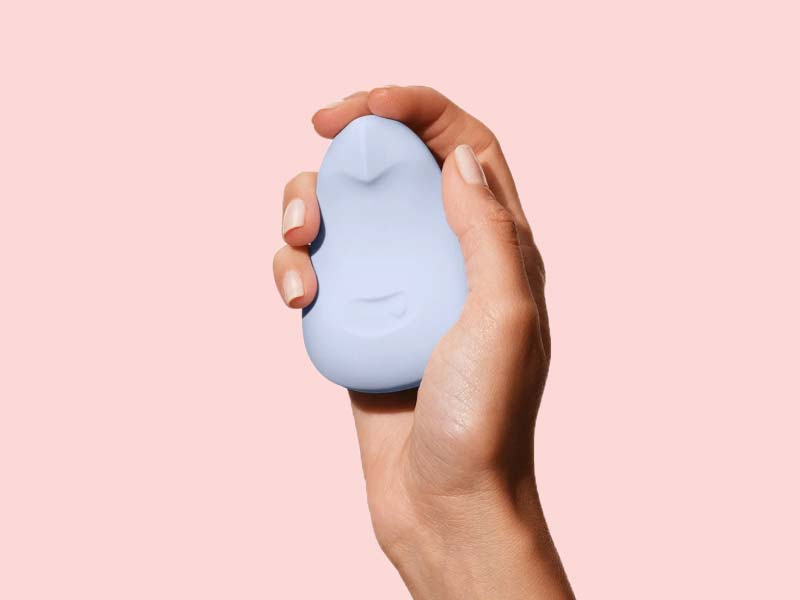
Can Men Get BV?
Published on March 26, 2025
Written by Kathleen Morrison
Medically Reviewed by Andrea Sleeth WHNP-BC, MSCP
It’s a question that comes up a lot, and it’s totally normal to wonder about it. BV (bacterial vaginosis) is a common vaginal infection that typically is something that affects people with vaginas (it's all in the name, isn't it?), but that doesn’t mean men aren’t part of the picture.
There’s a lot of confusion about whether men can get BV or even pass the bacteria back and forth. Knowing how BV works and how men are connected to it can help couples keep their health on track and improve communication around sexual health.
What is BV?
BV happens when the balance of bacteria in the vagina gets thrown off. Usually, the vagina has a mix of “good” and “bad” bacteria that keeps things in check, but sometimes, things shift.
Hormonal changes, douching, or even changes in routine can let the "bad" bacteria take over. That’s when BV can start showing up with signs like a fishy smell or thin discharge.
Sometimes, BV shows up without any noticeable signs, which can make it harder to catch without the help of a healthcare provider. Sex can also affect the vaginal environment, but BV isn’t quite the same as an STI.
So, Can Men Actually Get BV?
There’s a lot of back and forth about whether men can get BV like women do, and the simple(ish) answer is: not exactly.
BV primarily affects the vaginal microbiome, so men don’t develop the condition.
However, male sexual partners can carry the bacteria responsible for BV and pass it along, which can lead to a frustrating cycle for women who keep experiencing BV.
Understanding how this works can help couples break that cycle and focus on healthier, proactive habits to keep everyone feeling their best.
Can Men Spread BV?
Men may contribute to the spread of bacterial vaginosis by carrying and transferring bacteria between partners, even though they don’t get BV themselves.
The process starts when bacteria from a vagina get transferred during intimacy. Since penises and their accompanying parts aren’t made to house the same bacterial imbalance, they typically don’t show symptoms.
The bacteria can stick around on the skin or in the urethra, hanging out until they can move back. It’s similar to how someone can carry a cold virus without getting sick. This can create a cycle where the woman keeps getting BV because the bacteria never entirely leaves the situation.
That’s why healthcare professionals might suggest that both (male, female, or anything else!) partners look at their habits, especially if BV keeps coming back after treatment.
BV in Men: The Myths and Facts
There are a few myths around BV and men that can make things confusing.
One of the most common myths is that men can have BV just like women, complete with a fishy smell or discharge. The truth? Men can carry the bacteria without showing any signs or symptoms.
Another misconception is that not showering enough is the main cause of BV. In reality, it’s not just about hygiene—it’s about an overgrowth of certain bacteria, along with sexual activity and other factors. Even a man with excellent personal hygiene can still pass the bacteria along.
Understanding this can help couples realize why one partner might feel fine while the other deals with recurrent BV.
What if Men Experience BV Symptoms?
A lot of people think men can get BV and show up with symptoms like a fishy odor or gray discharge, but that’s not the case. Men’s bodies just don’t work that way—they don’t get that same bacterial imbalance.
So if a man notices some discomfort, it’s likely something else. It could be irritation in the urethra, a yeast imbalance, or maybe even a mild urinary issue. The best bet is to see a healthcare provider to figure it out.
When it comes to BV, the real question tends to be why one partner keeps dealing with it. A guy might start wondering if he’s unknowingly carrying the bacteria and passing it along, even though he doesn’t feel anything himself. This can happen because the bacteria can live outside the vagina and still get passed on. He might not even know it, which can confuse both partners when BV keeps coming back.
It might even lead to the thought that he’s “infected,” but BV is really just about that specific imbalance in the vagina—it’s not something men get in the same way.
Here’s how guys can stay on top of things if BV keeps coming back:
- Use condoms to help stop the spread of bacteria.
- Listen to their healthcare provider’s advice, especially if BV keeps showing up for their female partner.
- Pay attention to any changes or symptoms, even if they’re subtle.
By being proactive, keeping clean, and keeping the conversation open, couples can help avoid those annoying BV flare-ups and stay on the same page.
Conditions with Similar Symptoms in Men
If you’ve noticed discharge, itching, or discomfort, you might start wondering if it’s BV. But more often than not, it’s a different condition that just happens to share some similar signs. Getting to the bottom of it is super important because mistaking one issue for another can mean missing out on the right treatment.
Let’s clear up some common causes that might be behind those symptoms.
Thrush
Thrush, which is caused by an overgrowth of Candida yeast, can show up in men as redness or itching around the tip of the penis. You might also notice a white, cottage cheese–like coating under the foreskin.
This happens in warm, damp areas, so the skin around the genitals is a prime spot for yeast to thrive. Things like certain medications, too much sugar, or a weakened immune system can trigger an outbreak.
But don’t worry—over-the-counter antifungal creams usually do the trick, especially when combined with regular cleaning and drying of the area to keep moisture under control.
Beyond the meds: Other ways to improve sexual wellness
Medication isn’t the only way to improve sexual satisfaction. Desire and pleasure are influenced by hormones, mental health, relationships, and even your daily habits—so sometimes, a few lifestyle adjustments can make all the difference.
Sexually Transmitted Infections (STIs)
If menopause has brought on vaginal dryness or a dip in libido, hormone replacement therapy (HRT) could help.
By restoring estrogen and progesterone levels, HRT can improve vaginal moisture, boost mood, and make intimacy more comfortable. It’s not for everyone, but if your symptoms are linked to hormonal shifts, it’s worth discussing with a doctor.
Urinary Tract Infections (UTIs)
UTIs are less common in men, but they can still happen.
Symptoms include a burning feeling when you pee, feeling like you need to go but not much comes out, and possibly cloudy or smelly urine.
If you’re experiencing this, a course of antibiotics can usually take care of it, but it’s a good idea to check with a healthcare provider to make sure you’re on the right track. Things like dehydration, blockages, or certain health conditions can make UTIs more likely, so stay aware of any changes in your system.
Balanitis
Balanitis is the inflammation of the head of the penis, often caused by infections, skin issues, or not cleaning properly. It can lead to redness, soreness, and sometimes even discharge. The good news is that keeping things clean by gently washing with mild soap daily can make a big difference.
If there’s an infection involved, an antifungal or antibacterial cream might be recommended. The sooner you catch it, the better, as early treatment can help stop things from getting worse and help avoid any bigger problems down the line.
How Men Can Take Charge of their (and their partners’) Sexual Health
While men don’t experience BV the same way women do, they can still play an important role in keeping things balanced and supporting their partner’s health. Simple habits around personal care and communication can make a huge difference. Being proactive about the little things—like noticing your partner’s symptoms and speaking up when something feels off—can help nip potential issues in the bud and keep things running smoothly for everyone.
Play it Safe
Using condoms is one of the easiest ways to help keep bacteria from moving between partners. By reducing direct contact, they can stop harmful microbes from traveling to the vaginal area.
Regular STI testing is also a great habit to adopt, even if you’re not noticing any symptoms. Infections can often fly under the radar, only to show up later. Having open, honest conversations with your partner about sexual health makes it easier to stay on the same page.
When both people feel comfortable talking about their health, it’s much easier to handle any bumps along the way.
Keep it Clean
Personal hygiene is another simple way to keep things in check. A quick shower with a mild soap every day can do wonders, but be sure to avoid harsh products that can irritate the skin or mess with its balance.
For those who are uncircumcised, gently retracting the foreskin while washing and drying thoroughly is key—moist areas can encourage bacteria or yeast to thrive. And opting for looser, cotton underwear lets things breathe and stay dry.
Some people also like to add probiotics to their routine or cut back on sugar to support a healthy bacterial balance.
While these steps won’t treat that so-called “BV for men,” they can help keep everything clean and maintain a healthy balance of bacteria in the body to promote your overall sexual health—good for everyone involved!
How is BV Treated?
When BV is diagnosed, the main goal is to bring the vaginal microbiome back into balance. Men don’t always need specific BV treatments since they don’t experience the same imbalance, but they can still be part of the solution through partner therapy, careful checks, and some simple lifestyle changes.
Communication is key here—keeping things open with your partner and doctor helps make sure everyone stays healthy and in the loop.
Medical Treatments
Doctors usually prescribe women BV antibiotics like metronidazole or clindamycin, which can come as pills or vaginal gels. These help knock down the bad bacteria and let the good bacteria thrive again.
You may start feeling better in just a few days, but it’s important to finish the whole course of treatment to make sure the imbalance doesn’t come back. Some doctors might also recommend probiotics at this point, though there’s still some debate about how effective they really are.
While men don’t get BV, recent studies have found that treating the male partner with a combined oral and topical antimicrobial therapy has helped lower the recurrence of BV in their female partner—versus just standard antibiotics for just the female partner. So, with that in mind, it could be helpful for your male partner to get involved with medical treatment, too, though this isn’t recognized as standard care just yet.
A quick check-in after treatment is a good way to confirm that everything is back on track. If BV keeps coming back, it could mean there are other factors, like new sexual partners or hygiene habits, that need some attention.
Lifestyle and Home Remedies
In addition to treatment, some women find it helpful to make a few simple lifestyle changes, like wearing breathable cotton underwear and skipping harsh soaps or douching that could irritate sensitive areas.
Others swear by boric acid suppositories to help balance pH levels or adding yogurt and fermented foods to their diet to support a healthy balance of bacteria. These things don’t always work for everyone, but they can definitely help keep things in check.
Working Together for Better Sexual Health
Bacterial vaginosis isn’t something men “catch,” but they can carry the bacteria that causes trouble for their partner. If BV keeps coming back, it’s important for both partners to communicate and make sure no bacteria is being passed back and forth.
Remember, any irritation in men is usually from something else. Honest conversations and seeing a healthcare provider can help. Wisp is here to offer discreet, accessible sexual healthcare to help couples manage BV and take charge of their health together.
Frequently Asked Questions (FAQs):
What are the symptoms of BV in males?
Men don’t get BV itself, so they won’t experience the typical fishy odor or gray discharge. However, they can carry the bacteria behind BV, and any unusual signs in men usually point to a different condition.
Why does my bf keep giving me BV?
If your partner is carrying the bacteria, it might be passed back to you after treatment. Using protection and following advice from a healthcare provider can help break the cycle.
Can I transmit BV to my male partner?
While you can share bacteria during sex, it doesn’t cause the classic BV symptoms in men. However, he might pass the bacteria back to you later, which is why open communication and taking protective steps are so important.
How do men get rid of BV?
Men don’t need BV-specific treatment since they don’t get the condition. But they can help lower the chances of passing bacteria by staying clean, using condoms, and talking to a healthcare provider if they notice any issues.

BV Antibiotics (Tablets or Gel)
Request topical or oral prescription antibiotics to treat bacterial vaginosis.
Starting at $15.00
Get Started
Male BV Partner Support
Prescription BV partner care for patients assigned male at birth.
$99.00
Get Started

